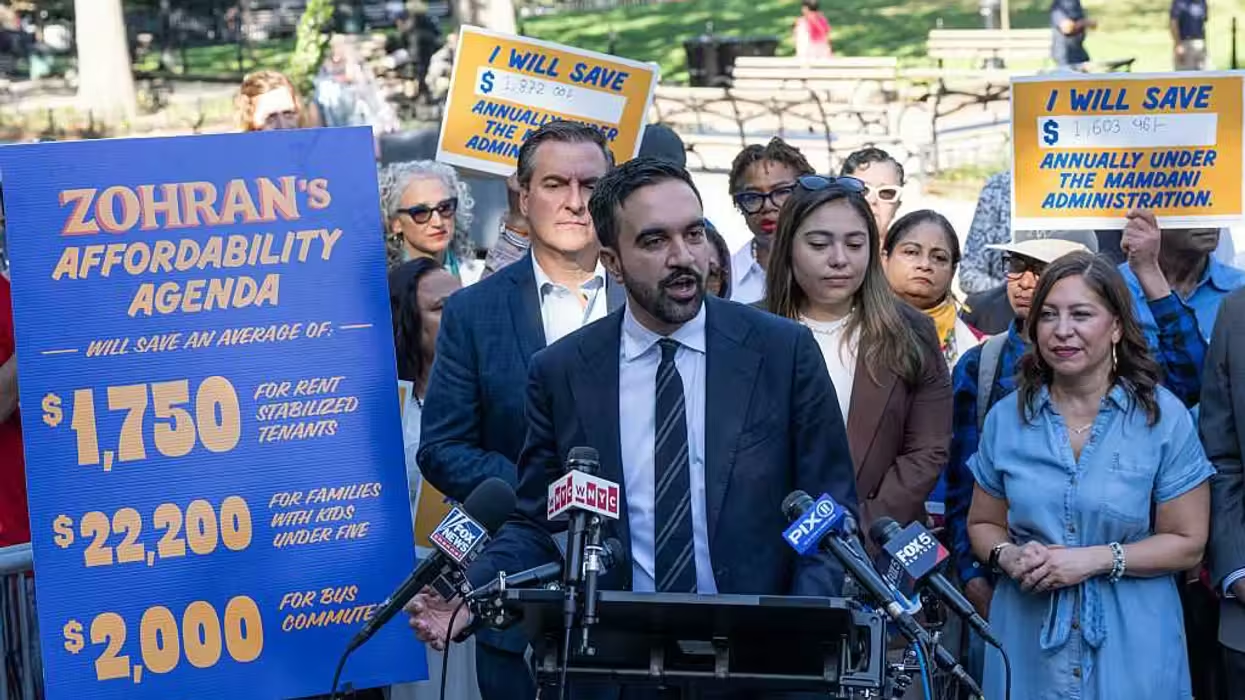
© 2025 Blaze Media LLC. All rights reserved.
. . . we are witnessing a "top-tier political battle in this major swing state, and a possible resurgence by the state Democratic Party."

A new Public Policy Polling survey claims Ohio Democrats and public employee unions are expected to overturn SB-5 and hand Republican Governor John Kasich a crushing defeat.
The poll shows only 36 percent of Ohioans will vote to support the law, while 59 percent oppose the bill and will vote to repeal it. From the poll's* authors :
Democrats are almost unanimous in their opposition to SB 5, supporting repeal by an 86-10 margin. Meanwhile there’s division in the Republican ranks- 30 percent are planning to vote down their Governor’s signature proposal while only 66 percent are supportive of it. Independents split against it by a 54/39 spread as well.
For those unfamiliar with the bill, Ohio Senate Bill 5 is similar to legislation passed by Wisconsin Gov. Scott Walker in that it addresses the collective bargaining rights of public sector employees.
With the passage of the Ohio bill, unions would still exist, but “striking would be illegal and there is a limit on what things can be bargained for,” reports the Ironton Tribune. Furthermore, unions could still negotiate working conditions and hours, but things such as healthcare and sick time off are off the bargaining table.
Here are some of the details of the bill as outlined by The Plain Dealer:
- Reduces the collective bargaining power of about 360,000 public workers in Ohio. The current collective-bargaining law gives workers the right to negotiate on a broad scope of topics including wages, hours, working conditions and any provision from an expiring contract that an employer wants to change. Under SB 5, workers no longer have the right to bargain changes from a previous contract.
- Bans public-worker strikes.
- Eliminates binding arbitration
- Eliminates “fair-share fees” - required payments to unions from workers who choose not to join their union.
- Places caps on paid personal days (three), paid holidays (12) and the amount of unused sick and vacation time a worker can cash in upon retirement.
- Eliminates automatic pay raises based on seniority and establishes a performance-based pay system.
- Prohibits seniority from being the sole factor considered when workers are laid off.
- Requires public workers to pay at least 15 percent of their health care costs and to contribute at least 10 percent of their salary toward their pension.
Kasich and the Republican legislature actually managed to pass the law earlier this year but it has yet to be put into effect. Unlike Wisconsin and Michigan, Democrats were able to hold up implementation of the bill by using the state referendum process to put the law directly on the ballot.
"Triggering a repeal referendum required organizers to collect signatures equal to just six percent of the total votes in the last gubernatorial election, with additional requirements that they be sufficiently spread out around the state, with at least three percent of the gubernatorial vote across at least half the counties in the state," reports TPM DC.
"That meant the threshold was 231,150 signatures — but organizers fired their opening political salvo by collecting four times as many, thus creating a greater base for the actual campaign," the report added.
What does this mean? According to TPM DC, it means that we are witnessing a "top-tier political battle in this major swing state, and a possible resurgence by the state Democratic Party."
Watch an anti-SB-5 TV spot produced by the pro-union We Are Ohio:
But let's take a closer look at the the survey that predicts total defeat for Gov. Kasich. As often repeated on The Blaze, whenever one confronts the results of a survey, even if they reinforce one's own argument, the following questions must be asked:
- Who were the respondents?
- How were individuals selected within chosen households?
- What was the non-availability of respondents?
- What was the refusal rate?
- How did they word the questions?
- What was the question order?
- Did they account for lying or false reporting by respondents, or inappropriate or inadequate weighing of data?
A quick look into the full results of the poll might help answer some of these questions.
For instance, consider question #1:
Issue 2 is a referendum on Senate Bill 5, which is a new law relative to government union contracts and other government employment contracts and policies. If the election was today, would you vote yes to approve this law or no to reject this law?
The options provided were: "Would vote yes on Issue 2 to approve Senate Bill 5," "Would vote no on Issue 2 to reject Senate Bill 5," and "Undecided."
It might be fair to say that this particular question is a good example of an incorrectly or awkwardly worded question that results in a sampling error. Indeed, the question is almost too vague for the respondent to give an informed answer. Exactly what bearing does SB-5 have on employment contract and policies? Because the question is too ambiguous to solicit a fair and informative result, the resulting data may not be indicative of the truth (not to say all Ohioans are unaware of SB-5 but that there could be enough unfamiliarity with the issue so as to skew the results).
Of course, not all of the questions were like that; some that were far from ambiguous. For instance, based on the question "Do you approve or disapprove of Governor John Kasich’s job performance?" the survey data reports that Gov. Kasich has a 57 percent disapproval rate, a mere 33 percent approval rate, and 10 percent are "not sure."
And here is another interesting part of the survey. Of the respondents who participated in the survey, this is how they identified themselves:
Very liberal ...................................................... 7%Somewhat liberal ............................................ 20%
Moderate......................................................... 31%
Somewhat conservative.................................. 25%
Very conservative ........................................... 18%
What do you suppose those numbers imply?
A final note: if the survey is indeed accurate, and it is true that a vast majority of Ohioans support overturning the collective bargaining bill, conservative radio talk show host Rush Limbaugh has a message for them:
If this [polling data] is true, then people in Ohio want to rape themselves! They want to pay higher taxes to pay higher salaries to state workers who will earn twice what their private sector counterparts are earning!That's what Public Policy Polling is telling us is going on in Ohio.
*The survey of likely voters was conducted over the weekend, from November 4-6, and has a ±3.1 percent margin of error. The survey was collected from 1,022 likely voters from November 4th to 6th. The survey was conducted through automated telephone interviews.
Want to leave a tip?
We answer to you. Help keep our content free of advertisers and big tech censorship by leaving a tip today.
Want to join the conversation?
Already a subscriber?
more stories
Sign up for the Blaze newsletter
By signing up, you agree to our Privacy Policy and Terms of Use, and agree to receive content that may sometimes include advertisements. You may opt out at any time.
Related Content
© 2025 Blaze Media LLC. All rights reserved.
Get the stories that matter most delivered directly to your inbox.
By signing up, you agree to our Privacy Policy and Terms of Use, and agree to receive content that may sometimes include advertisements. You may opt out at any time.






